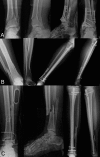When is indicated fibular fixation in extra-articular fractures of the distal tibia?
- PMID: 30657124
- PMCID: PMC6502107
- DOI: 10.23750/abm.v89i4.7775
When is indicated fibular fixation in extra-articular fractures of the distal tibia?
Abstract
Background and aim of the work: There is no consensus about indications for fibular osteosynthesis in extra-articular fractures of the distal tibia (DTF). This study analyses patients affected by DTF associated to fibular fracture and has the aim to define whether the level of fibular fracture has an influence on bone healing and consequently when its fixation is indicated.
Methods: Eighty-seven patients were operated from January 2005 to December 2016. Inclusion criteria were: the presence of skeletal maturity, the absence of physical limitations before trauma and a type 43-A AO closed fracture. Clinical outcomes were evaluated using Olerud-Molander Ankle Score (OMAS) and the Disability Rating Index (DRI). Malrotation was also assessed as well as incidence of nonunion and malalignment through x-rays.
Results: No differences in clinical scores were reported at follow-up between patients in which fibular fixation was performed (Group 1) in comparison with those in which this procedure was not executed (Group 2). Nonunions were registered in 8 cases: four in Group 1 and four in Group 2. A statistically significant difference in incidence of external malrotation and valgus malalignment between the groups was documented, with a higher risk in patients of the second group.
Conclusions: The level of fibular fracture is important to determine when the fixation of this bone is indicated. In supra-syndesmotic fractures osteosynthesis leads to a higher incidence of nonunions. Fibular osteosynthesis could prevent malrotation and malalignment and is advisable in distal metaphyseal fracture of this bone (trans- or infrasyndesmotic lesion) with syndesmotic injury.
Figures
Similar articles
-
Distal leg fractures: How critical is the fibular fracture and its fixation?Orthop Traumatol Surg Res. 2010 Oct;96(6):667-73. doi: 10.1016/j.otsr.2010.07.002. Epub 2010 Sep 20. Orthop Traumatol Surg Res. 2010. PMID: 20851076
-
To fix or not to fix? The role of fibular fixation in distal shaft fractures of the leg.Injury. 2014 Feb;45(2):408-11. doi: 10.1016/j.injury.2013.09.017. Epub 2013 Sep 21. Injury. 2014. PMID: 24129327
-
Assessment of the role of fibular fixation in distal-third tibia-fibula fractures and its significance in decreasing malrotation and malalignment.Injury. 2013 Dec;44(12):1885-91. doi: 10.1016/j.injury.2013.08.028. Epub 2013 Sep 8. Injury. 2013. PMID: 24074830 Clinical Trial.
-
Ankle fractures involving the fibula proximal to the distal tibiofibular syndesmosis.Foot Ankle Int. 1997 Aug;18(8):513-21. doi: 10.1177/107110079701800811. Foot Ankle Int. 1997. PMID: 9278748 Review.
-
Concomitant Distal Tibia-Fibula Fractures Treated with Intramedullary Nailing, With or Without Fibular Fixation: A Meta-Analysis.J Foot Ankle Surg. 2021 Jan-Feb;60(1):109-113. doi: 10.1053/j.jfas.2020.05.006. Epub 2020 Nov 17. J Foot Ankle Surg. 2021. PMID: 33218862 Review.
Cited by
-
Dair approach in 7 infected total hip arthroplasties: our experience and current concepts of the literature.Acta Biomed. 2022 Mar 10;92(S3):e2021572. doi: 10.23750/abm.v92iS3.12603. Acta Biomed. 2022. PMID: 35604248 Free PMC article. Review.
-
Simulation-based prediction of bone healing and treatment recommendations for lower leg fractures: Effects of motion, weight-bearing and fibular mechanics.Front Bioeng Biotechnol. 2023 Feb 20;11:1067845. doi: 10.3389/fbioe.2023.1067845. eCollection 2023. Front Bioeng Biotechnol. 2023. PMID: 36890916 Free PMC article.
-
External fixator combined with three different fixation methods of fibula for treatment of extra-articular open fractures of distal tibia and fibula: a retrospective study.BMC Musculoskelet Disord. 2021 Jan 4;22(1):1. doi: 10.1186/s12891-020-03840-y. BMC Musculoskelet Disord. 2021. PMID: 33397351 Free PMC article.
-
Biomechanics of Osteoporotic Fracture Fixation.Curr Osteoporos Rep. 2019 Dec;17(6):363-374. doi: 10.1007/s11914-019-00535-9. Curr Osteoporos Rep. 2019. PMID: 31755030 Free PMC article. Review.
-
The Role of Fibular Fixation in Distal Tibia-Fibula Fractures: A Meta-Analysis.Adv Orthop. 2021 Feb 25;2021:6668467. doi: 10.1155/2021/6668467. eCollection 2021. Adv Orthop. 2021. PMID: 33708447 Free PMC article. Review.
References
-
- Close JR. Some applications of the functional anatomy of the ankle joint. J Bone Joint Surg Am. 1956;38:761–81. - PubMed
-
- Scranton PE, Jr, McMaster JG, Kelly E. Dynamic fibular function: a new concept. Clin Orthop Relat Res. 1976;118:76–81. - PubMed
-
- Bourne RB, Rorabeck CH, Macnab J. Intra-articular fractures of the distal tibia: the pilon fracture. J Trauma. 1983;23:591–6. - PubMed
-
- Ovadia DN, Beals RK. Fractures of the tibial plafond. J Bone Joint Surg Am. 1986;68:543–51. - PubMed
-
- Kimmel LA, Edwards ER, Liew SM, Oldmeadow LB, Webb MJ, Holland AE. Rest easy? Is bed rest really necessary after surgical repair of an ankle fracture? Injury. 2012 Jun;43(6):766–71. - PubMed
MeSH terms
LinkOut - more resources
Full Text Sources
Medical
Research Materials


